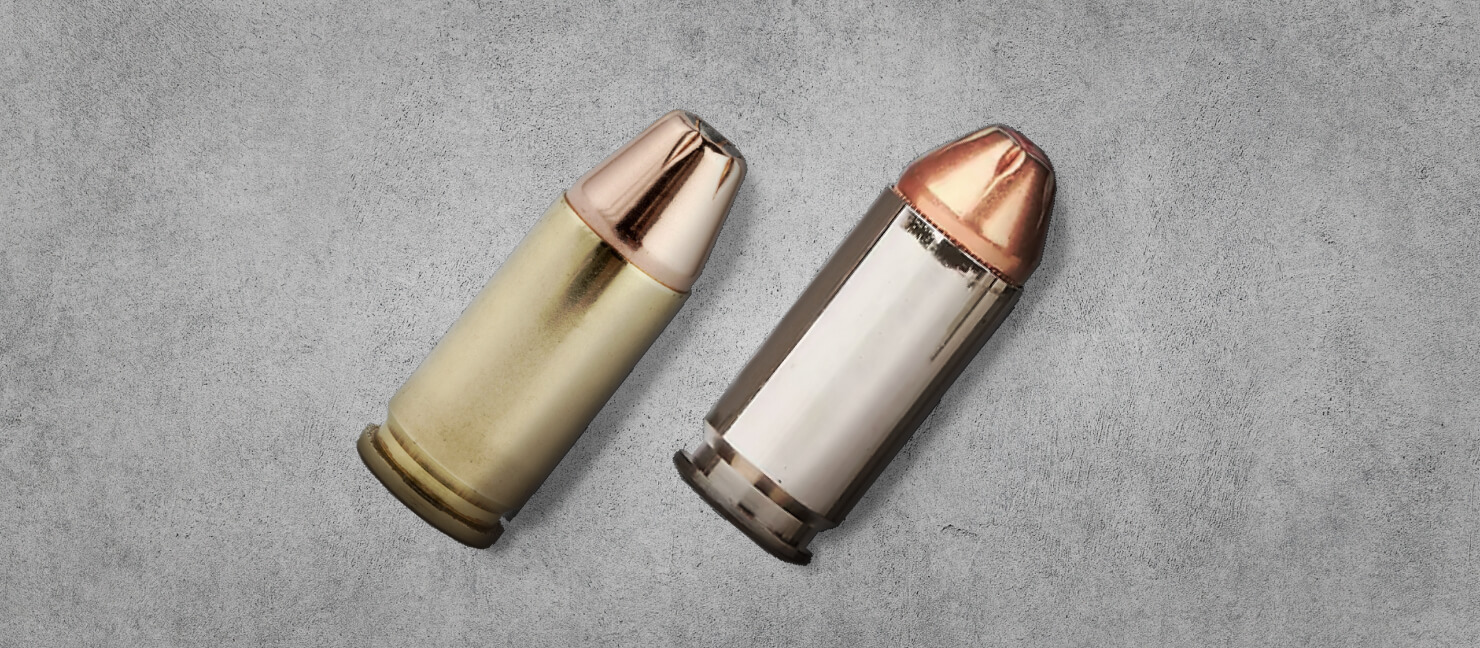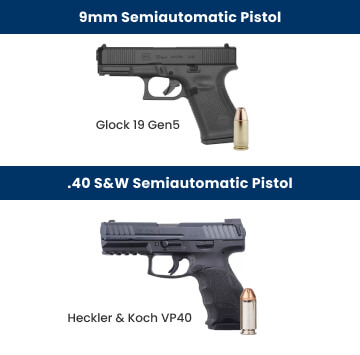9mm vs .40 S&W: Battle of the Cartridges

Diving into the world of handguns and can't decide between the sleek 9mm luger and the robust .40 S&W? You're in the right place! This guide throws these two cartridges into the ring and compares their performance, history, and usage. By the time you're through, you'll have all the insights needed to pick the perfect champion for your holster.
Key Takeaways
- 9mm & .40 S&W: What You Need to Know: The 9mm offers higher magazine capacity and lower grain weight, giving it a variety of purposes. The .40 S&W has a larger diameter and usually higher grain weight, well-suited for personal defense.
- 9mm vs .40 S&W: Which Is Better? The 9mm is a great choice overall for its lower recoil, larger magazine, and availability. However, if higher stopping power is what you’re going for, you should consider the .40 S&W.
- 9mm vs .40 S&W Pros & Cons: The 9mm is cost-effective and versatile with lower recoil, ideal for beginners and varied uses, whereas the .40 S&W is recognized for its stopping power and effectiveness in law enforcement roles, at the expense of higher recoil and ammunition cost.
- Which One Should You Choose? The 9mm is perfect for those valuing capacity and manageability, and the .40 S&W is for those prioritizing stopping power and velocity and are comfortable with snappy handling.
- History of the 9mm & .40 S&W: The 9mm cartridge is a global standard for military and personal defense due to its balance of power and capacity. The .40 S&W was created to meet former FBI specs for power and recoil and is still a top choice for U.S. law enforcement.
9mm & .40 S&W: What You Need to Know

| 9mm and .40 S&W: The Basics | ||
|---|---|---|
| Category | 9mm | .40 S&W |
| Bullet Diameter | 0.355 in. | 0.40 in. |
| Case Length | 19.15mm (0.754 in.) | 21.59mm (0.850 in.) |
| Overall Length | 29.69mm (1.169 in.) | 27.94mm (1.100 in.) |
| Bullet Weight Range | 92-147 grains Most popular: 115, 124 grains |
60-180 grains Most popular: 165, 180 grains |
| Recoil | Generally lighter | More pronounced |
| Magazine Capacity | Often higher | Usually lower |
| Popular Firearm Models | Glock 19, Sig P320, Beretta 92, CZ 75 | Glock 23, Smith & Wesson M&P40, Springfield XD |
The actual performance of these cartridges varies based on specific loads and individual firearm characteristics. The choice between 9mm and .40 S&W depends on personal preference, intended use (self-defense, competition, or target shooting), and the firearm being used.
9mm vs .40 S&W: Which Is Better?
The 9mm and .40 S&W cartridges cater to various shooting styles and preferences. Many prefer the 9mm for its smaller size, allowing for a higher magazine capacity and generally lower recoil. The 9mm is also a favorite among law enforcement and military personnel worldwide. Its lower cost and greater availability in various types make it an economical option for frequent training and use in compact and full-size firearms.
On the other hand, the .40 S&W’s larger size naturally results in a lower magazine capacity than the 9mm. The increased bullet diameter and weight contribute to higher recoil which could impact aim and handling for less experienced shooters. Due to its higher stopping power, the .40 S&W is preferred by some shooters. However, it is generally more expensive and less common than the 9mm.
| 9mm vs .40 S&W Comparison Chart | ||
|---|---|---|
| Category | .9mm | .40 |
| Size | Bullet diameter of 9.01mm Rim thickness of 0.90mm |
Larger bullet diameter of 10.2mm Thicker rim of 1.4mm |
| Magazine capacity | Generally higher (e.g., Beretta 92: 15 rounds, Glock 17: 17 rounds) | Generally lower (e.g., Beretta 96: 12 rounds, Glock 22: 15 rounds) |
| Trajectory | Similar to the .40 S&W | Similar to the 9mm |
| Velocity | 990-1400 fps | 950-1440 fps |
| Usage | Popular worldwide, U.S. military, self-defense | U.S Law enforcement, Canada, Australia, self-defense |
Size
The 9mm boasts a streamlined and compact design with a bullet diameter of 9.01mm (0.355 inches). Its compact design allows for a higher magazine capacity. The 9mm's smaller neck, base, and rim dimensions make it suitable for a wide array of handguns.
The .40 S&W cartridge's larger 10.2mm (0.400 inches) bullet diameter offers a broader impact area. The dimensions of its neck, base, and rim are significantly larger than those of the 9mm. Many law enforcement agencies prefer the .40 S&W for its stopping power and manageable recoil.

Magazine Capacity
Magazine capacity favors the compact cartridge design of the 9mm. For example, firearms like the Beretta 92 and Glock 17 hold up to 15 and 17 rounds, respectively. The .40 S&W cartridge results in a generally lower magazine capacity. For instance, the Beretta 96 holds 12 rounds, while the Glock 22 holds 15 rounds.
Trajectory
The 9mm and .40 S&W rounds have similar performance characteristics and demonstrate almost identical trajectories. Despite differences in size and power, the bullets behave comparably in flight and perform consistently in wind drift, bullet drop, and target impact rate.
Velocity
Velocity comparisons show the 9mm achieving speeds between 990 and 1400 feet per second, whereas the .40 S&W propels bullets at velocities ranging from 950 to 1440 feet per second. This range indicates that both cartridges offer comparable speed, with specific velocities varying by ammunition model and firearm.
Usage
The 9mm is the most prevalent cartridge globally and is favored by the U.S. military and widely employed for self-defense. Its popularity stems from its balanced performance and versatility. The .40 S&W is popular among law enforcement in the United States, Canada, and Australia for its effective stopping power and manageable handling characteristics.
9mm vs .40 S&W Pros & Cons
9mm Pros
|
9mm Cons
|
.40 S&W Pros
|
.40 S&W Cons
|
Expert Tip:
It is worth noting the .40 S&W is snappy and produces more muzzle flip, but you can still master the handgun like any other.
Which One Should You Choose?

Choosing between the 9mm and .40 S&W involves considering your specific needs, preferences, and level of shooting experience. Each type of ammo offers unique benefits that might make it more suitable for different purposes and users. Here are some characteristics of each to help you make an informed decision.
Beginner’s Guide to 9mm
The 9mm is ideal for those new to shooting or seeking a balance of capacity, control, and cost. Its primary advantage is the higher magazine capacity and having to reload less often. The 9mm also has less recoil for easier control. 9mm cartridges also benefit from lower ammunition costs, making it more cost-effective for regular practice.
The versatility of the 9mm makes it well-suited for a range of activities from self-defense to sport shooting. Its range of sub-compact to standard size options also lends itself perfectly to concealed carry.
Overview of .40 S&W
The .40 S&W is the go-to option for those prioritizing stopping power in their handgun. This cartridge is ideal for law enforcement and individuals seeking the most reliable personal defense solution. This .40 S&W is recommended for shooters comfortable with managing its sharper recoil, which comes as a trade-off for its increased velocity and size.
It's important to note that the .40 S&W ammunition typically costs more than the 9mm and has a lower magazine capacity, but these factors may not be an issue for shooters who prefer a higher-powered handgun.
Expert Tip:
If you are looking for a concealed carry option, both 9mm pistols and .40 S&W pistols are available in compact sizes at Academy Sports + Outdoors.
History of the 9mm & .40 S&W
.9mm Cartridge:
The 9mm cartridge has its roots in the earlier 7.65x21mm Parabellum developed by Georg Luger. Luger removed the bottleneck design of the original cartridge to develop a tapered and rimless design. This design was adopted by the German Navy in 1904 and the German Army in 1906.
The 9mm's popularity surged post-World War I and laid the foundation for its widespread use today. The 9mm has become the most common cartridge for law enforcement in the U.S. and is extensively used by military and law enforcement agencies worldwide. Its efficiency, reliability, and suitability for self-defense have cemented its place in firearm history.
.40 S&W Cartridge:
The .40 S&W cartridge was developed to meet specific FBI requirements following the 1986 Miami shootout. The goal was to create a cartridge that could function reliably with the ballistics of 10mm ammunition but without its significant recoil.
Smith & Wesson took on this challenge and designed the .40 S&W using a small pistol primer. Although this new cartridge gained traction among law enforcement agencies for its stopping power and manageable recoil, the FBI shifted back to the 9mm in 2016, and military branches are currently using the 9mm as well.
Have Fun Out There!
Ready to elevate your shooting experience? Explore our extensive collection of 9mm ammo and .40 S&W ammo alongside a wide range of 9mm pistols and .40 S&W pistols at Academy Sports + Outdoors. We feature top brands to ensure you find the perfect match for your firearm needs. Gear up for your next day at the range with confidence.


